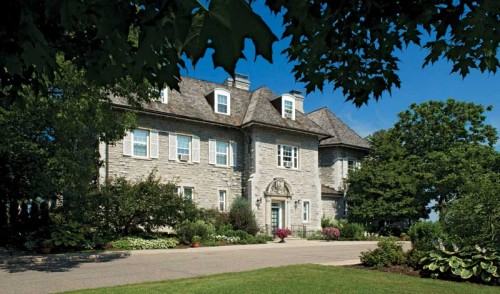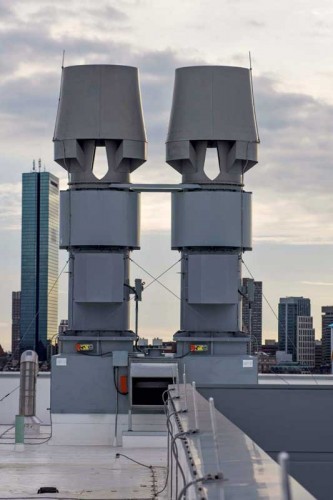Lightning Protection: Five concepts you need to understand

It takes into account a building’s environment, construction type, occupancy, and contents, plus the consequences. The appendix provides a formula for assessing the risk of a lightning damage:
R = (A + B + C + D +E) / F
where:
R = Risk, rated from 0 (light) to over 7 (severe).
A = Structure type, ranging from 1 for small single-family residences to 10 for hospitals, nursing homes, housing for the elderly or handicapped, and buildings containing hazardous materials.
B = Construction type, ranging from 1 through 5, depending on materials used for the structural framework and roof.
C = Relative location, ranging from 1 for small structures near higher structures to 10 for structures extending more than 15 m (50 ft) above adjacent structures or terrain.
D = Topography, ranging from 1 for flat land to 5 for mountain tops.
E = Occupancy and contents, ranging from 1 for noncombustible material in unoccupied buildings to 10 for historic content or explosives.
F = Lightning frequency (annual mean number of days per year with thunderstorms), ranging from an index of 9 for areas with five or fewer days to and index of 5 for areas with 30 to 40 days per year—the maximum expected in Canada.
NFPA cautions that there is need for protection in some cases regardless of the outcome of the risk assessment, including buildings with:
- large crowds;
- critical services;
- tall, isolated structures;
- irreplaceable cultural heritage; and
- statutory, regulatory, or insurance requirements that take precedence over risk assessment.
The risks of an unprotected structure should be balanced against the modest cost of installing lightning protection. Roof area is the most significant factor in determining the work required to install lightning protection. This means a multi-storey edifice costs less per square metre of interior floor area than a single storey building would. Costs to install LPS are higher in buildings with extensive rooftop equipment and demanding architectural considerations, and are less in buildings with a modicum of rooftop equipment and a simple configuration. Buildings taller than
25 m (82 ft) are considered Class II structures under CAN/CSA B72 and will incur additional expenses. Understandably, structures such as tall chimneys (Class III) or those housing hazardous occupancies (Classes IV and V) have greater complexity and cost. (A construction cost study, suitable for budgeting LPS in the early stages of project design can be downloaded at www.ecle.biz/coststudy. Based on U.S. construction costs, it must be adjusted based on exchange rates and local market conditions.)

3. Lightning protection systems
The fundamentals of lightning protection have been recognized and improved on for more than 200 years. (In brief, the LPS provides a low-resistance path with adequate capacity for lightning’s electrical charge. Air terminals are placed at locations most likely to be the launching point for a lightning strike. They are interconnected via highly conductive cables that lead to ground electrodes. For additional information, visit www.lightning.org)
CAN/CSA B72 has not been updated in three decades and some subject matter experts advocate the standard has not kept pace with the advances in lightning protection. These experts now recommend that lightning protection meet the following codes in addition to the Canadian standard:
- National Fire Protection Association (NFPA) 780, Standard for the Installation of Lightning Protection Systems;
- Lightning Protection Institute (LPI) 175, Standard of Practice for the Design, Installation, Inspection of Lightning Protection Systems;
- UL 96, Lightning Protection Components;
- UL 96A, Installation Requirements for Lightning Protection Systems;
- UL 497, Protectors for Paired-conductor Communications Circuits; and
- UL 1449, Surge Protective Devices.
In practice, CAN/CSA B72 is similar to the NFPA, LPI, and UL standards. For optimal protection, however, specifications should require compliance with both sets of standards and that the more stringent clause govern in case of conflicts. (An example of a practice allowed under the Canadian standard but not NFPA is the ‘intercepting conductor.’ This practice omits air terminals and relies on horizontal cables conductors laid directly against roofing to be the contact point for a lightning strike. Many subject matter experts say this practice offers less protection and can result in damage to roofing. On the other hand, the Canadian standard is more restrictive in some regards. It limits the maximum distance between an air terminal and a roof edge to 0.5 m (1.6 ft) instead of 0.6 m (2 ft) as allowed by NFPA.)
Quality Assurance
Until 2011, the Ontario Lightning Rod Act regulated who could manufacture, install, and inspect lightning protection installations, assigned jurisdiction to the provincial fire marshal, and assured a high level of quality. The act and similar ones in other provinces are now rescinded, making it essential specifiers establish clear quality criteria for their projects. (Regarding a progenitor of the current standard: “In no case has a building rodded under the Lightning Rod Act been destroyed by lightning after having been inspected by the Fire Marshal’s Office.” This comes from Keller, H.C. Keller’s “Results of Modern Lightning Protection in the Province of Ontario,” Farm Paper of the Air.)
Design
The Lightning Protection Institute’s program to certify individuals as Designer Inspectors (DIs) or Master Installer Designers (MIDs) has wide acceptance in the U.S. Until this or a similar system is established in Canada, the design of an LPS is best left to an experienced lightning protection contractor. The designer can be prequalified, or specifications can state requirements such as five years of experience on projects of similar size and complexity within the province.
Fabrication
Lightning protection components should be fabricated to comply with UL96; products fabricated for electric power systems are not sized to handle a lightning strike. A full product line—including clamps, couplings, fasteners, and accessories—requires more than 2000 stock keeping units (SKUs) plus customization capabilities to meet the full range of construction conditions.
Installation
The International Association of Electrical Inspectors (IAEI) states, “installation of a lightning protection system is much different from the installation of electrical service wiring.” Installers can be prequalified, or specifications can state requirements such as five years of experience on projects of similar size and complexity within the province. (See Soares Book on Grounding and Bonding, page 444 of the 12th ed. published in 2014.)
Inspection
While most installers will guarantee their work meets the applicable codes, third-party inspection can be seen as part of the building commissioning process. New Brunswick and Saskatchewan have provincial inspection programs. UL has an inspection program and issues a ‘Master Label Certificate’ or ‘Letter of Findings’ if a project meets their criteria. While not widely used in Canada at this time, there is growing interest in the Lightning Protection Institute-Inspection Program’s Master Installation Certificate.







